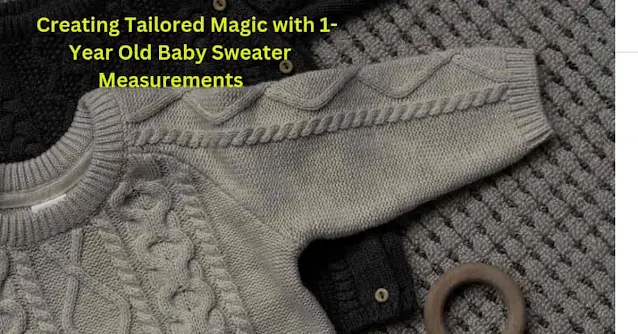1 Year Old Baby Sweater Measurements
Are you excited about crafting a cozy sweater for your precious 1 year old baby ? Making adorable sweaters for babies is a delightful endeavor that allows you to showcase your creativity while keeping your little bundle of joy warm and stylish. One crucial aspect that often gets overlooked is ensuring the perfect fit through accurate measurements.
Just like us, babies deserve the utmost comfort in their clothing, and that starts with a well-fitting sweater.
So, let's explain 1-year-old baby sweater measurements and discover the key to creating a garment that fits like a hug.
After all, a sweater made with love and tailored to perfection is a gift that will be cherished for years to come.
Understanding Knitting 1 year old baby sweater measurements
In order to make a well-fitting sweater for your 1year old baby, it is important to have a clear understanding of the key measurements involved. Let's go through each measurement in detail:
- Chest Circumference:
Chest girth is the measurement of the widest part of the child's upper body, just below the armpits.
To measure this, wrap a flexible measuring tape gently around your child's chest, making sure it is comfortable but not too tight. Make sure the tape is parallel to the ground for accurate results.
Note down the measurements in inches or centimeters, as these will be essential for choosing the right sweater size and ensuring a comfortable fit.
- Length:
Sweater length refers to the measurement from the shoulder to the desired hemline. This measurement determines how long the sweater will fit on your little one.
To measure length, place the measuring tape over the top of the child's shoulder and extend it down to the desired point, whether it's at the hips, waist, or slightly lower.
Make note of this measurement, as it will help you determine the ideal length for the sweater.
- Sleeve Length:
Sleeve length is the measurement from shoulder to wrist for long sleeves or desired length for short sleeves.
For long sleeves, start at the point of the shoulder and measure up to the wrist, making sure the measuring tape follows the natural curve of the arm.
If you prefer shorter sleeves, measure up to the desired point on the child's arm, whether it's above or below the elbow.
The precise measurement of sleeve length ensures that the sleeve is neither too short nor too restrictive.
- Shoulder Width:
It is equally important to measure the width of the child's shoulders to get a well-fitting sweater.
Place the measuring tape at the edge of one shoulder and extend it horizontally to the edge of the other shoulder.
This measurement ensures that the sweater's shoulders align with your child's frame, providing a comfortable fit and allowing for easy movement.
Choosing the Right Size: Baby Sweater Measurement
A general size chart or reference can be incredibly helpful when it comes to choosing the right size for your one year old baby sweater.
While sizes may vary depending on the brand or pattern you're using, here's a general guideline based on average measurements for 1 year olds.
- Chest girth:
Typically, a one-year-old baby's chest girth ranges from 18 to 20 inches (45 to 50 cm). However, it's best to measure your child's chest and refer to the specific size chart provided by the pattern or yarn manufacturer.
- Length:
The length of one year old baby sweaters can vary depending on personal preference. On average, a length of 11 to 13 inches (28 to 33 cm) from shoulder to hemline is appropriate.
Adjust this measurement according to the style you want and the baby's proportions.
- Sleeve length:
For long sleeves, a typical sleeve length is 9 to 11 inches (23 to 28 cm) from shoulder to wrist. However, consider your child's arm length and adjust accordingly.
The short sleeves can be customized to your liking, ending above or below the elbow.
While choosing a size, it is important to keep your child's growth in mind as babies grow rapidly, so it is wise to choose a size that has some room for growth.
The slightly loose fit will ensure that the sweater can be worn comfortably for long periods of time.
"Choose a size that allows freedom of movement, especially in the shoulders and arms."
"Always refer to the pattern or yarn manufacturer's size chart for the most accurate guidance, as different designs may have their own specific size recommendations"
Tools and Techniques For 1-Year Old Baby Sweater Measureme
- Flexible measuring tape
- Paper and pen:
- Choose the right time:
- Create a calm environment:
- Engage and distract:
- Be gentle and patient:
- Make it a game.
- Keep the session short:
Tips For Customizing 1 Year Baby Sweaters
- Importance of using baby's measurements:
- Adjustment of Pattern to Yarn Weight:
- Modifying Stitch Count:
- Length Adjustment:
- Sleeve Modification:
- Consider the ratio of the child:











.jpg)
0 Comments:
Post a Comment